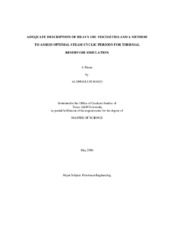| dc.description.abstract | A global steady increase of energy consumption coupled with the decline of conventional oil resources points to a more aggressive exploitation of heavy oil. Heavy oil is a major source of energy in this century with a worldwide base reserve exceeding 2.5 trillion barrels. Management decisions and production strategies from thermal oil recovery processes are frequently based on reservoir simulation. A proper description of the physical properties, particularly oil viscosity, is essential in performing reliable modeling studies of fluid flow in the reservoir. We simulated cyclic steam injections on the highly viscous Hamaca oil, with a viscosity of over 10,000 cp at ambient temperature, and the production was drastically impacted by up to an order of magnitude when using improper mixing rules to describe the oil viscosity. This thesis demonstrates the importance of these mixing rules and alerts reservoir engineers to the significance of using different options simulators have built in their platforms to describe the viscosity of heavy oils. Log linear and power mixing rules do not provide enough flexibility to describe the viscosity of extra heavy oil with temperature. A recently implemented mixing rule in a commercial simulator has been studied providing satisfactory results. However, the methodology requires substantial interventions, and cannot be automatically updated. We provide guidelines to improve it and suggest more flexible mixing rules that could easily be implemented in commercial simulators. We also provide a methodology to determine the adequate time for each one of the periods in cyclic steam injection: injection, soaking and production. There is a lot of speculation in this matter and one of the objectives of this thesis is to better understand and provide guidelines to optimize oil production using proper lengths in each one of these periods. We have found that the production and injection periods should be similar in time length. Nevertheless, the production period should not be less than the injection period. On the other hand, the soaking period should be as short as possible because it is unproductive time in terms of field oil production for the well and therefore it translates into a negative cash flow for a company. | en |


